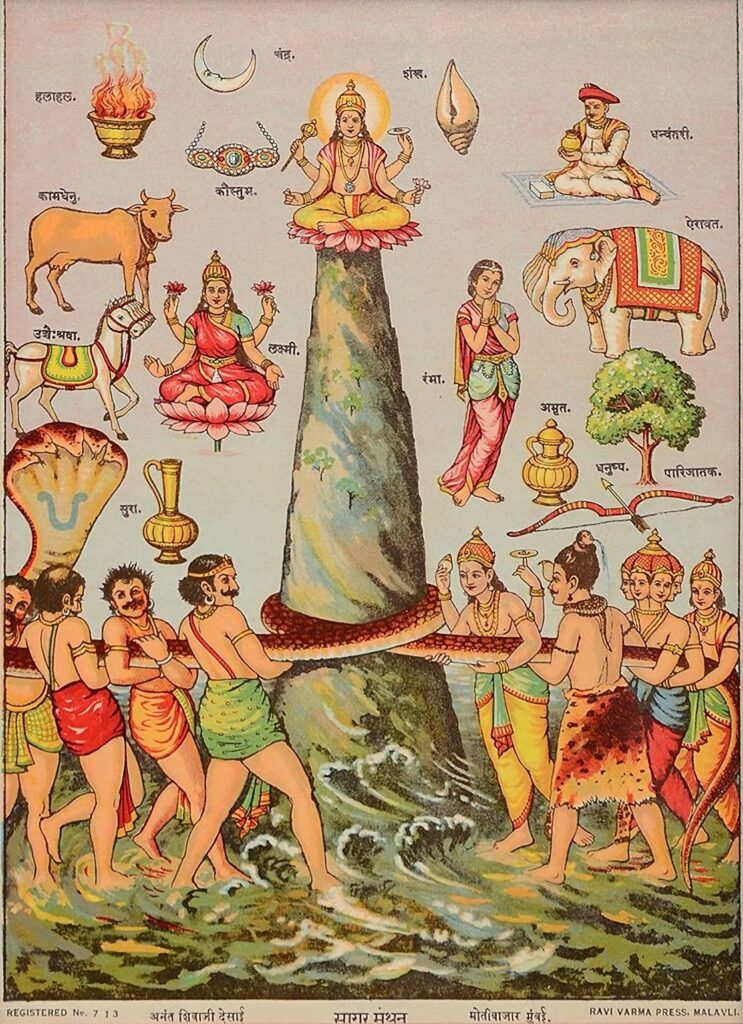The story of Samudra Manthan, also known as the Churning of the Ocean of Milk, is a famous episode from Hindu mythology, particularly found in the ancient texts like the Mahabharata, the Vishnu Purana, and the Bhagavata Purana. This tale is rich in symbolism and is a key narrative in the mythology of the Hindu gods and the cosmic struggle between good (the Devas) and evil (the Asuras). Here’s a summary of the story:
Background
The Devas (gods) and the Asuras (demons) were constantly at odds, vying for power over the universe. At one point, the Devas, having been weakened and defeated by the Asuras, sought the help of Lord Vishnu to regain their strength and immortality.
The Plan
Vishnu advised the Devas that to regain their strength, they would need to obtain the nectar of immortality, called Amrita, which lay hidden at the bottom of the cosmic ocean of milk. However, retrieving it would require a massive effort, and the only way to do it was to cooperate with the Asuras, promising to share the nectar with them.
The Churning Process
- Mount Mandara as the Churn: The Devas and Asuras decided to use Mount Mandara as the churning rod and the great serpent Vasuki as the churning rope. Vishnu, taking the form of a giant turtle named Kurma, supported Mount Mandara on his back, preventing it from sinking into the ocean.
- Churning Begins: The Devas and Asuras pulled Vasuki back and forth, causing Mount Mandara to rotate and churn the ocean. During the churning, several items and beings emerged from the ocean:
- Halahala: A deadly poison that threatened to destroy all life. Lord Shiva swallowed the poison to save the universe, holding it in his throat, which turned blue, earning him the name Neelkantha.
- Various Treasures and Divine Beings: These included the celestial cow Kamadhenu, the divine horse Uchchaihshravas, the tree Kalpavriksha, the goddess of fortune Lakshmi, the moon Chandra, and the divine nymphs Apsaras.
- Emergence of Dhanvantari and Amrita: Finally, Dhanvantari, the divine physician, appeared holding the pot of Amrita. Upon seeing the nectar, the Asuras immediately seized the pot, breaking their agreement with the Devas.
The Deception of Mohini
To prevent the Asuras from consuming the nectar and becoming immortal, Vishnu took the form of a beautiful enchantress named Mohini. Distracted by her beauty, the Asuras agreed to let her distribute the Amrita. Mohini cleverly served the nectar only to the Devas, while the Asuras were given ordinary water.
The Rahu-Ketu Incident
One of the Asuras, named Rahu, disguised himself as a Deva and consumed some of the nectar. However, before it could pass down his throat, Vishnu, in his Mohini form, realized the deception and beheaded him with the Sudarshana Chakra. Rahu’s head became the demon Rahu, and his body became Ketu, both of whom are associated with eclipses in Hindu astrology.
Aftermath
With the Devas having consumed the nectar, they regained their strength and defeated the Asuras, restoring balance to the universe. The churning of the ocean also symbolizes the spiritual quest for truth and immortality, with the various elements representing different aspects of the cosmic order.
Symbolism
- Samudra Manthan: Represents the continuous struggle between good and evil, and the effort required to attain enlightenment or immortality.
- Halahala (Poison): Symbolizes the trials and challenges one must endure in the quest for spiritual wisdom.
- Amrita (Nectar of Immortality): Represents the ultimate reward of spiritual attainment, immortality, and divine knowledge.
The story of Samudra Manthan is thus a profound allegory of human life and the cosmic order, illustrating the importance of cooperation, sacrifice, and the eternal struggle for good over evil.
Related Articles:
